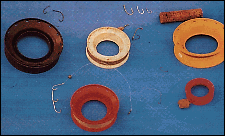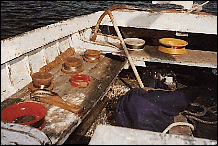Hand Lines
 The most simplest form of fishing is the usage of the humble hand-line. Now a days, technology offers us the luxury carbon fibre and fibre glass rods with single mould cast alloy reels. But all this technology doesn't compensate for experience that is also required. The most simplest form of fishing is the usage of the humble hand-line. Now a days, technology offers us the luxury carbon fibre and fibre glass rods with single mould cast alloy reels. But all this technology doesn't compensate for experience that is also required.
Hand-lining was something I started at a very young age, catching my first Tommy Ruff with. Fish in those days were more abundant, more frequent to catch due to their numbers, and the hand-line saw no end of hookups.
Tackle in those days would normally comprise of an old canvas bag, filled with a dozen or so hand-lines made of cork or turned out of old softwood crates. The hand-lines were filled with light line for bream fishing, a flathead rig or two, some for surface fishing and a bait line.
This variety was the key to success, for no matter what type of fish was about, you had a rig ready for it. The results were that a day's catch would cover a range of species and give the angler an enormous amount of practical experience to draw on for the future.
Hand-lining brings back memories of a time when I was on Moonta Bay Jetty at 4.00am. At that time in the morning, it was common place to have the whole jetty to ones self. By 5.00am, the top end of the jetty was buzzing with activity from dozens of anglers all fishing for squid, and believe it or not, all using hand-lines.
 Hand-lining is particularly useful in shallow, calmer waters, where you have to wait a bit longer for the action to happen. The more baits in the water, the more chances you have of a hookup. With multiple hookups, one would wish there were two of you ! Hand-lining is particularly useful in shallow, calmer waters, where you have to wait a bit longer for the action to happen. The more baits in the water, the more chances you have of a hookup. With multiple hookups, one would wish there were two of you !
When fishing, hand-lines take up a lot of room when being used. It is vital not to have obstacles in the way as loose loops of line can easily tangle and cut short the fight of a good fish.
Baits should be checked frequently. Smell also plays an important part in attracting fish. The longer a bait is left in the water, the less effective it becomes as a fish attractor. This point is relevant to all forms of fishing and is one of the major reasons why anglers have poor results . . . Laziness!
Hand-line fishing allows the fish plenty of time to swallow the bait, so most fish are gut hooked. Don't try and overpower the fish. Big lazy flathead can be gently coaxed to the boat and minimal pressure will ensure the line doesn't break through the fight.
When using hand-lines, another golden rule is 'not to move your feet'. A good fish will take line during the fight, so free loops of line must be available when the fish decides to run.
Last, but by no means least, is the cast. A lot of effort and patience has gone into positioning yourself into the 'right spot' so why is it that so many anglers stand up with a hand-line, wind it up like they were throwing a discus, and try to pelt it into oblivion ? A simple underhanded lob is sufficient to get your bait out. This also helps keep the bait looking like it should be presented, instead of a screaming blob that the 'G' forces have distorted out of shape.
Hand-lining fishing is extremely simple, and with simplicity, cheap as well. It offers anglers an excellent opportunity to learn the basics at a much easier pace and is a great way to introduce siblings to the joys of fishing.
Practiced at dawn and dusk, especially from jetties, this form of fishing can be enjoyed with expected results of a reasonable catch.
 Fishing Tip : Fishing Tip : |
|
| Why not contact fishSA.com about your Fishing Tip |
|
|